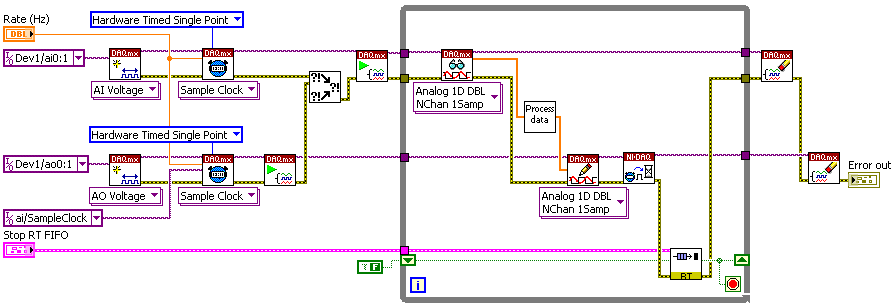LabVIEW Example—Hardware-Timed Simultaneously Updated I/O with Data Exchanges between Time-Critical and Non-Time-Critical Loops
 |
Note Although this example is written for LabVIEW users, the principles apply if you are using another ADE, such as LabWindows/CVI. |
- Wire the Wait For Next Sample Clock VI to one of the hardware-timed tasks. Use dataflow wiring to guarantee that the Wait For Next Sample Clock VI executes after the AO Write call.
- Use dataflow wiring to guarantee that the real-time FIFO operations execute after the Wait For Next Sample Clock VI executes.
- If the Wait For Next Sample Clock VI does not execute before the arrival of the next sample clock edge, it returns an error.
Sample Block Diagram

Notes
- Use only one Wait For Next Sample Clock VI within a LabVIEW loop. If you have multiple hardware-timed I/O tasks within the same LabVIEW loop, you can connect the Wait For Next Sample Clock VI to any one hardware-timed single-point task within that loop.
- If, when a cycle overflow occurs, you want to receive a warning rather than an error, set the DAQmx Real-Time»Convert Late Errors to Warnings property to True.
- Although you do not have to place the real-time FIFO code after the Wait For Next Sample Clock VI, it is highly recommended that you do so when dealing with multiple-channel analog input operations on multiplexed devices (such as E and M Series). Because the device can spend up to 50% of the sample period converting samples on the analog input channels, executing the FIFO code during this conversion period has the advantage of using up otherwise idle time.
- You can increase the Analog Input Conversion Rate manually through the DAQmx Timing Property Node. This reduces the total amount of time spent converting the requested number of samples. It is important to consider the minimum settling time specifications for the complete data acquisition system to avoid signal degradation and interference.